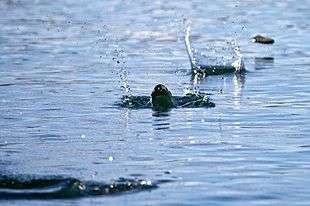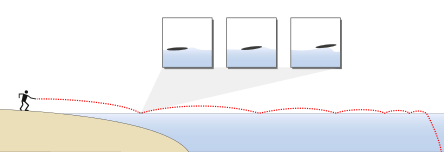Stone skipping

Stone skipping (or stone skimming) is the art of throwing a flat stone across water in such a way (usually Sidearm) that it bounces off the surface, preferably many times. The objective of the game is to see how many times a stone can bounce before sinking.
Championships and records
The North American Stone Skipping Association (NASSA), founded by Coleman-McGhee, in 1989 and is based in Driftwood, Texas, sanctioned world championships for four years from 1989 through 1992 in Wimberley, Texas. The next official NASSA World Championships is expected to be held at Platja d'en Ros beach in Cadaqués, Catalonia, Spain.
The world record for the number of skips Guinness Book of Records is 88 by Kurt "Mountain Man" Steiner, (b. 1965). The cast was achieved on September 6, 2013 at Red Bridge in the Allegheny National Forest, Pennsylvania.[1] The previous record was 65 skips, by Max Steiner (no relation to K. Steiner), set at Riverfront Park, Franklin, Pennsylvania. Before him, the record was 51 skips, set by Russell Byars on July 19, 2007, skipping at the same location.[2] Kurt Steiner also held the world record between 2002 and 2007 with a throw of 40 skips, achieved in competition at Franklin, PA. The US Stone Skipping champion 2018 at Franklin was Keisuke Hashimoto (Japan), at Mackinac Island Mich 2018 it was David Kolar.
A stone skipping championship of a different nature takes place every year in Easdale, Scotland, where relative distances count as opposed to number of skips, as tends to be the case outside the US.[3] Since 1997, competitors from all over the world have taken part in the World Stone Skimming Championships in a disused quarry on Easdale Island using sea-worn Easdale slate of maximum 3" diameter.[4] Each participant gets three throws and the stone must bounce/skip at least twice to count (ie 3 water touches minimum).[5] The 2018 World Champion there is Peter Szep (Hungary) and the Women's World Champion Lucy Wood (England). Other title holders from competitions held within the past year include Nina Luginbuhl (Switzerland) Welsh Open women's champion 2018;[6]; Alex Lewis (Scotland) 2018 British & 2018 All England; Katalina Tupou (Samoa) 2018 British Women's; Christina Bowen-Bravery (England) 2018 All England Women's; Kurt Steiner (USA) 2018 Welsh Open; Thierry Luginbuhl (Switzerland) 2018 Swiss. A table of WSSC Easdale title holders follows. Paul Crabtree (England) was the inaugural European champion in 2012. Events require use of natural stone except for the Welsh. The world record for distance skimmed using natural stone was laser-surveyed at 121.8 metres (400 ft), at a Guinness-endorsed event held at Abernant Lake, Llanwrtyd Wells, Powys, Wales on Monday 28 May 2018. The record was made by Dougie Isaacs of Scotland. The first women's distance record was also established at the same event – 52.5 metres (172 ft) thrown by Nina Luginbuhl of Switzerland.
Men's World Championship winners by year
| Year | Men's champion | Nationality |
|---|---|---|
| 2018 | Peter Szep | Hungary |
| 2017 | Keisuke Hashimoto | Japan |
| 2016 | Dougie Isaacs | Scotland |
| 2015 | Dougie Isaacs | Scotland |
| 2014 | Dougie Isaacs | Scotland |
| 2013 | Dougie Isaacs | Scotland |
| 2012 | Ron Long | Wales |
| 2011 | Dougie Isaacs | Scotland |
| 2010 | Dougie Isaacs | Scotland |
| 2009 | David Gee | England |
| 2008 | Eric Robertson | Scotland |
| 2007 | Dougie Isaacs | Scotland |
| 2006 | Tony Kynn | Australia |
| 2005 | Dougie Isaacs | Scotland |
| 2004 | Andrew McKinna | Scotland |
| 2003 | Ian Brown | Scotland |
| 2002 | Alastair Judkins | New Zealand |
| 2001 | Iain MacGregor | Australia |
| 2000 | Scott Finnie | Scotland |
| 1999 | Ian Shellcock | England |
| 1998 | Ian Shellcock | England |
| 1997 | Ian Sherriff | New Zealand |
Women's World Championship winners by year
| Year | Women's champion | Nationality |
|---|---|---|
| 2018 | Lucy Wood | England |
| 2017 | Nina Luginbuhl | Switzerland |
| 2016 | Lucy Wood | England |
| 2015 | Lucy Wood | England |
| 2014 | Helen Mannion | Scotland |
| 2013 | Lucy Wood | England |
| 2012 | Lucy Wood | England |
| 2011 | Joanne Giannandrea | Scotland |
| 2010 | Manuela Kniebusch | Germany |
| 2009 | Tessa Pirie | Scotland |
| 2008 | Jillian Hunter | Northern Ireland |
Scientific explanation

An early explanation of the physics of stone-skipping was provided by Lazzaro Spallanzani in the 18th century.
The stone generates lift in the same manner as a flying disc, by pushing water down as it moves across the water at an angle. Surface tension has very little to do with it. The stone's rotation acts to stabilize it against the torque of lift being applied to the back.
Research undertaken by a team led by French physicist Lydéric Bocquet discovered that an angle of about 20° between the stone and the water's surface is optimal.[7] Bocquet and his colleagues were surprised to discover that changes in speed and rotation did not change this fact, it just allow the stone to be in balance and to continue with a straight and uniform movement, due to gyroscopic effect.[7] Work by Hewitt, Balmforth and McElwaine has shown that if the horizontal speed can be maintained skipping can continue indefinitely.[8] Earlier research reported by Bocquet calculated that the world record of 38 rebounds set by Coleman-McGhee, unchallenged for many years, required a speed of 12 m/s (25 mph), with a rotation of 14 revolutions per second.[7]
Names
- English: "skipping stones" or "skipping rocks" (North America), "stone skimming" or "ducks and drakes" (Britain), "stone skiffing" (Ireland)[9]
- Bengali: "frog jumps" (Bengachi); "kingfisher" ("Machhranga")
- Bosnian/Croatian/Montenegrin/Serbian: "(to throw) little frogs" ((bacati) žabice)
- Bulgarian: "frogs" (жабки)
- Cantonese: "skipping (little) stones" (片石(仔) [pin sek (tzai)])
- Catalan: "making step-stone bridges" (fer passeres), "making furrows" (fer rigalets), "skipping stones" (llençar passanelles)
- Czech dělat (házet) žabky/žabičky (to make/throw froggies – countrywide and generally intelligible. Some regions and dialects used also: dělat kačky/kačeny/kačery/kačenky/káčata/káčírky (to make ducks/drakes/ducklings, esp. in East Bohemia and parts of Moravia) rybičky/rybky (little fishes), mističky (saucers), talíře (plates/dishes), podlisky/podlíšky/lyšky (wagtails), potápky (divers), pokličky/pukličky (pot-lids), plisky, plesky (flaps), žbluňky (plops), šipky (darts), bubliny (bubbles), židy (Jews), páni/panáky (sirs/figures), babky (gammers/wagtails), panenky (dolls/girls/dragonflies), převážet panenku Mariu (to ferry Virgin Mary), and many others.[10]
- Danish: "slipping" (smut or at smutte), "to make slips" (at slå smut)
- Estonian: "throwing a burbot" (lutsu viskama)
- Finnish: "throwing bread/a sandwich" (heittää leipiä/voileipiä)
- French: (faire des ricochets)
- Greek: "little frogs" (βατραχάκια)[11]
- Hungarian: "making it to waddle", lit. "making it walk like a duck" (kacsáztatás)
- Italian: rimbalzello
- Japanese: "cutting water" (「水切り」[mizu kiri])
- Korean: Mulsujebi (Hangul: 물수제비; RR: mulsujebi), meaning water (Hangul: 물; RR: mul) and Korean soup sujebi.
- Lithuanian: "making frogs" (daryti varlytes)
- Macedonian: "frogs" (жабчиња)
- Mandarin: (打水漂 [da shui piao])
- Marathi: ([bhakrya kadhne])
- Mongolian: "making the rabbit leap" (tuulai kharailgakh) or "making the dog lick" (nokhoi doloolgokh)
- Norwegian: "fish bounce" (fiskesprett)
- Polish: "letting the ducks out" (puszczanie kaczek)
- Portuguese "little fish" (peixinho) or "little seashells" (conchinhas)
- Russian: "baking pancakes" (печь блины [pech blini])
- Spanish: "making white-caps" (hacer cabrillas), "making little frogs" (hacer ranitas), "making little toads" (hacer sapitos)
- Swedish: "throwing a sandwich" (kasta smörgås or kasta macka)
- Telugu: "frog jumps" (kappa gantulu)
- Turkish: "skimming stone" (taş sektirme)
- Ukrainian: "letting the frogs out" (zapuskaty zhabky)
See also
- Animal locomotion on the water surface
- Bouncing bomb
- Ricochet
- Rock balancing (another hobby or pastime using stones)
- Skip bombing
References
- ↑ "Most skips of a skimming stone".
- ↑ Silver, Jonathan D. (2007-09-30). "A stone's throw and then some to a Guinness record". Pittsburgh Post-Gazette.
- ↑ "BBC NEWS - UK - Scotland - Scots dominate in stone skimming". news.bbc.co.uk.
- ↑ "World Stone Skimming Championships 2007". www.scotlandontv.tv. Archived from the original on 2008-10-23.
- ↑ "World Stone Skimming Championships, Easdale Island". www.stoneskimming.com. Archived from the original on 2017-12-13.
- ↑ "World Stone Skimming Championships results". www.stoneskimming.com.
- 1 2 3 Clanet C, Hersen F, Bocquet L (January 2004). "Secrets of successful stone-skipping". Nature. 427 (6969): 29. doi:10.1038/427029a. PMID 14702075.
- ↑ I. J. Hewitt; N. J. Balmforth & J. N. McElwaine (2011). "Continual Skipping on Water". J. Fluid Mech. 669: 328–353. doi:10.1017/S0022112010005057.
- ↑ The Secrets of Stone Skipping, Coleman-McGhee, 1996, ISBN 1-883856-01-9
- ↑ Český jazykový atlas 1 (Czech Language Atlas 1), Academia, Prague, 2004, pp. 110–113, (dělat) žabky
- ↑ "Archived copy". Archived from the original on 2013-08-03. Retrieved 2013-07-29.
Further reading
External links
| Wikimedia Commons has media related to Stone skipping. |
| Look up ducks and drakes in Wiktionary, the free dictionary. |
- John Zehr's Patent, "Skipping stones and method of use thereof",US Patent 4553758
- John "Skippy" Kolar Skipumentary
- NASSA homepage
- Easdale's Stone Skimming World Championships
- World Championships on the BBC
- Wales Open Stone Skimming Championships
- Mackinac Island Stone Skipping & Gerplunking Club
- The Stone Skipping Hall of Fame (virtual)
- European Championships Stone Skimming
- Rock in River Festival, Pennsylvania Stone Skipping Championship
- European Championship Stone Skimming